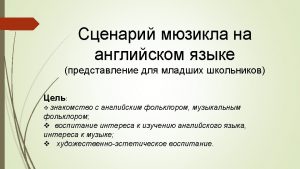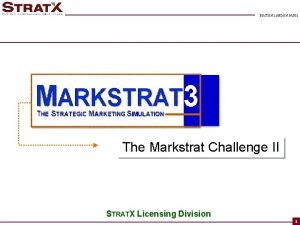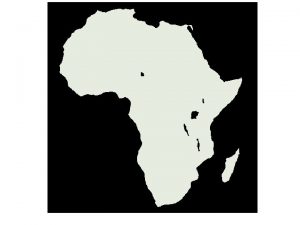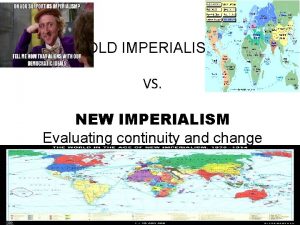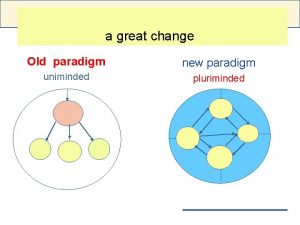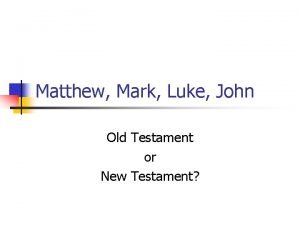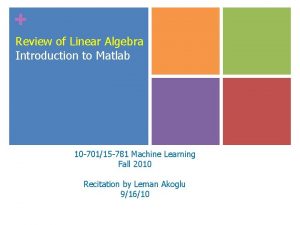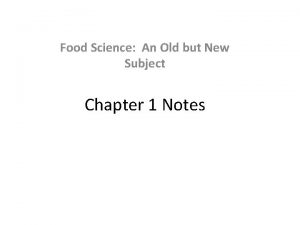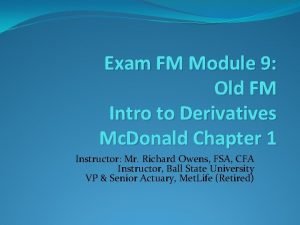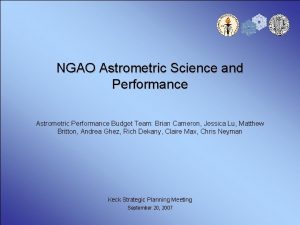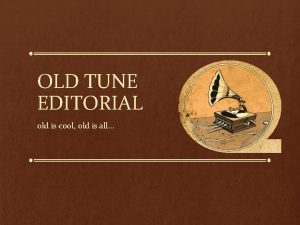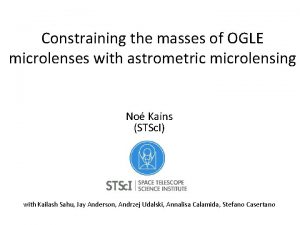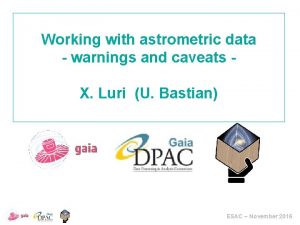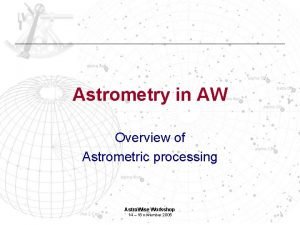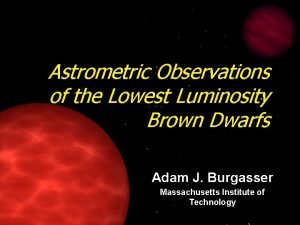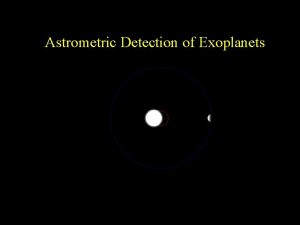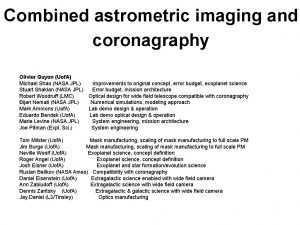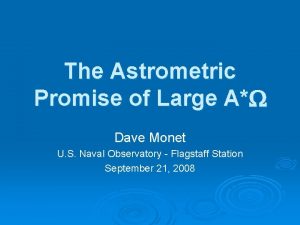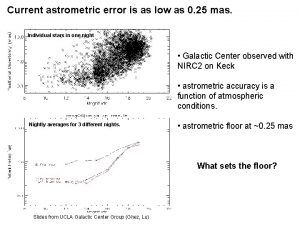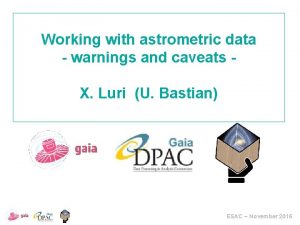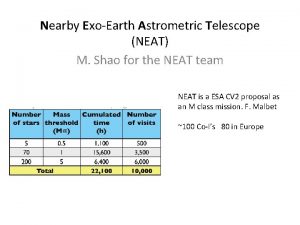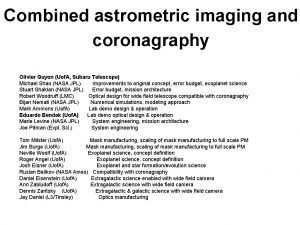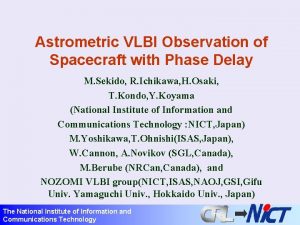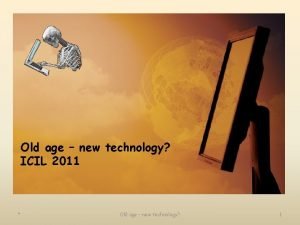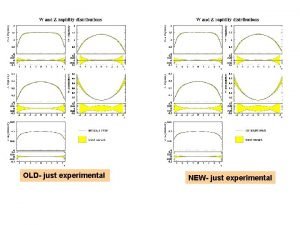Project NAROO A New Astrometric Reduction of Old



























































- Slides: 59

Project NAROO A New Astrometric Reduction of Old Observations Project of creating a centre for sub-micrometric measurements of astronomical photographic plates and of image analysis J. E. Arlot – CIAS Oct. 14 -18, 2015

The project • Making a new reduction of old observations: « observing in the past » • Analyzing old data especially photographic plates • Creating a center for digitizing and analyzing old data but not for saving only old photographic plates • Emphazing the scientific goals: astrometry, celestial mechanics, dynamical systems and evoluting systems with time

The status of old data • More interest for old data in the framework of solar system evolution studies • Several different projects – – Archiving Saving Photometry Spectrometry • Work at IMCCE in solar system dynamics and astrometry – Maintaining data bases – Reducing astrometric observational data • Progress of reference star catalogues (UCAC, URAT) • Progress of technology: sub-micrometric scanners • Arrival of the GAIA reference star catalogue

The progresses of astrometry

Hipparcos Gaia Epoq 1991. 25 ≈2013. 5 Receptor photomètre CCD Aperture Ø=0. 29 m 1. 45 x 0. 5 m input catal. oui non Limiting mag. (V) 12. 5 20 Density 3* /deg 2 (TYC 2=50) 25000 * /deg 2 Radial V non 10 km/s (V=16. 5) Photometry 0. 015 (V=9) 0. 001 (V=15) 1 mas (V=9) 7 µas (V=10) 10 -25 µas (V=15) 300 µas (V=20) (~100 -1000 µas Asteroids) astrometry

The star proper motions provided by Gaia will allow to reduce old data with today accuracy

Observational techniques of solar system objects Technique Present accuracy Objects Improvement Transit circle 50 100 mas mag 6 -15 probably Scanning telescope 50 100 mas mag 20 possible Tangential focal plane images 20 2000 mas all yes Planets through satellites 20 50 mas Mars, Giant planets yes, only for giant planets AO, IR a few mas (relative) inner objects no? Photometric events 1 10 km (relative) main planetary satellites, asteroids no, depends on size of objects Gaia 0. 1 1 mas mag 7 20 50 obs. /5 years VLBI, Doppler space probes 2 10 mas objects visited by space probes yes for obs. with stars Radar 10 100 m Near Earth Objects no LLR 1 3 cm The Moon no 7

The present star catalogues Year Name Nb of stars Mag limit Accuracy mas Accuracy pr motions Origin 1997 Hipparcos 120 000 12. 4 < 0. 78 < 0. 88 m/y obs. from space 2000 Tycho 2 2 500 000 16 < 60 < 2. 5 m/y from Tycho and 143 sources 1998 USNO A 2 526 280 881 2001 GSC II 19 000 2003 USNO B 1 1 billion 2004 UCAC 2 2004 360 Schmidt plates 21 200 Schmidt plates 48 000 7. 5 16 20 70 Bright stars 430 000 < 7. 5 2005 Nomad 1 billion 2006 Bordeaux 2 970 674 15. 4 50 70 2003 2 MASS 470 000 16 60 100 Infra red 2015 GAIA 1 billion 20 < 0. 01 mas obs. from space 1 7 m/y scans Hipparcos + Tycho 2 compilation of best entries 1. 5 6 m/y +11° > d > +18° 8

Scientific goals • Observing evoluting events with time (dynamics, photometry) • Extracting new informations from old data • Getting one order of magnitude in accuracy – New scanning machines – New reduction softwares – New reference star catalogues • UCAC 2, UCAC 4, GAIA, …

Scientific goals Astrometry: • Dissipation of energy because of tides in the planetary satellites system: constraints on the formation of the systems and on the internal structure • Solar system ephemerides extrapolation • Pre-discoveries of NEO and TNO Spectrometry • Pre-discoveries of extra-solar planets in old spectra Photometry • Evolution of the photometry of variable stars (Be stars)

Observing in the past • the number of available plates makes necessary the coordination of this task • selecting plates from scientific purpose – Objects – Period of time • scanning the plates with adapted scanners and optimal criteria (pixel size, accuracy of positioning, …) • reducing them starting with UCAC 2 waiting for GAIA • keeping images and distortion parameters for later re-reduction 11

What are old data? • Photographic plates made from the end of the XIXth century • CCD observations made in the 1980’s • Space astrometric data made in the XXth century • All observations made and reduced before the Gaia catalogue

Old observations 1) Photographic plates • Since 1890 • Large or small fields • « Carte du ciel » , astrographs, large refractors, Schmidt telescopes

The « Carte du ciel » 33 cm astrograph of Bordeaux Observatory f = 3, 43 m; scale = 60’’/mm

Greenwich astrographs Refractor 13 inches (1890) f=3 m 43 Refractor 26 inches (1896) f= 5 m 44

Long focus astrographs The USNO 61 -inch refractor f= 10 m; scale = 20 ’’/mm The 38 cm refractor of Bordeaux Obs. f = 6, 82 m; scale = 30’’/mm

Looking for positions of comets one century ago

Jupiter system From « Carte du ciel » instruments with mask with filter

Galilean Satellites of Jupiter (refractor f=10 m) extraction of not « visible » stars

Saturnian system USNO photographic plate taken in the 1970’s; f=10 m

Satellites of Mars f=10 m

Plates with Mars, Phobos et Deimos Phobos os im De 26

Pre-discoveries of asteroids (NEO, TNO, …)

The criteria of digitization -Choosing the criteria for digitization -Size of a pixel, photometric dynamic -From negative to positive -Reciprocity curve -Accuracy of positioning (depending on the scanner? )

Photographic plate errors · mapping defects of the optics, · larger scale systematics due to centering errors of the optical system, · effects from the mechanical and darkroom processes, non homogeneous developing, rinsing and drying of the plates. All this can and will produce systematic and random errors of any correlation length (i. e. the emulsion shifts are correlated over mm or cm range). • Reference stars will be used to reduce these errors

Digitizing plates Digitizing a photographic plate may be made: · ‘on the fly’ (using a digital detector moving with constant speed in one direction) · ‘on the step’ (using a digital detector at rest). The digital detector could be: - a CCD (Charge Coupled Device) - a CMOS (Complementary Metal Oxide Semiconductor) It may have: · only one pixel (zero dimensional), · a row of pixels (one dimensional) or · an array of pixels (two dimensional).

Needs for the project • Digitizing in secure files • High astrometric accuracy (sub-micrometric) • The best choice for the digitizing criteria (resolution, precision, speed, photometric dynamic) • New softwares for analyzing the images and for the reduction

The material • A sub-micrometric digitizing scanner – astrometry vs photometry – high accuracy vs fastness – softwares for extracting information • Collaborations – Other laboratories – Observations outside the solar system – Non astronomical plates

The other projects for digitization • MAMA - observatoire de Paris (1000 nm) • Starscan – U. S. Naval Observatory (500 nm) ___________________________ • Harvard University scanning « Historic Sky Project » (1000 nm) • Pulkovo Fantasy digitizer (1000 nm) • DAMIAN-Royal Observatory of Belgium (70 nm) • Our project NAROO: a sub-micrometric scanner (70 nm) Our project

Preliminary works (1) • Convention with the Royal Observatory of Belgium for using the DAMIAN scanner for test plates « USNO 1967 -1998 » • Test of star catalogues (UCAC 2, USNO-A 2) • Evaluation of errors all along the digitizing process: – – – – Positioning of the plate: 2 nm Static repeatability Dynamical repeatability Distorsion of the optics Recording on CCD Converting into fits file Final precision: 70 nm

Preliminary works (2) • Optimizing digitizing criteria – Size of the pixel – Photometric dynamics – Recording into secure files • New reduction methods – Extracting the sources – Increase of precision referred to the former manual measurements – Starting the reductions with catalogues such as UCAC 2, 4 or similar (precision 50 mas) – Preparing the reductions with the future catalogues and Gaia (precision < 1 mas)

The selection of old data to be re-reduced Example: using the database of natural satellites to select the old data to be re-reduced • Satellites of Mars: 3000 observations from 1877 to 1988 (14 per year per satellite) Need to digitize plates from 1990’s in order to avoid gap • Galilean satellites of Jupiter: 12000 observations from 1891 to 2001 (27 observations per year per satellite) Need to digitize old plates from 1890’s in order to improve old data and all un-reduced observations Need to reduced data in intersatellites into RA and DEC • Main satellites of Saturn 50641 observations from 1874 to 2003 (49 observations per year per satellite) Need to digitize plates from 1920’s to avoid gaps Need to reduced data in intersatellites into RA and DEC 36

Choosing a digitizing machine (1) - Airbearing XY-table, with cooled CMOS camera. - Power LED illumination in transmission mode. - Grayscale images. - Sizes up to : 350 mm x 350 mm sheets or plates; - Resolution: 7µm x 7µm pixels , (3620 dpi). - Geometric final accuracy: 0. 07µm. - Scan speed: 24 cm x 24 cm image in less than 10 min. - Data stream: 10 MB/s. - Production: 24 x 7, maintenance < 5%.

Choosing a digitizing machine (2) - Automatic conversion of analogue images into digital images. - Post processing and data extraction in near real time. - Distributed software and hardware architecture. - Climatised clean room and archive room (20° 0. 1° C, 50% 1% RH)

The machine successfully tested in Belgium Bench marks with USNO plates

Preliminary works • Identification of interesting targets – Icy Satellites – Irregular Satellites – Pre-décoveries of NEO and TNO • Inventory of accessible plates – – Large number of available plates (until 200 000 plates) Plates with a field from a few minutes of degree to several degrees Plates from 1890 with metadata Plates in good shape

Inventory Pulkovo observatory

Inventory objects (Pulkovo obs. ) • • Saturn and its satellites – 800 plates (1972 -2007). Jupiter and Galilean satellites – 500 plates (1976 – 2005). Mars – 763 plates (1960 -1988). Uranus and its satellites – 250 plates (1910 -2004). Neptune – 237 plates (1899 -1955). Pluto – 272 plates (1930 – 1994) 18 selected asteroids – 2655 plates (1949 -2004)

Inventory: Greenwich observatory Curtis Schmidt / Cerro Tololo Stonyhurst Discs, 8. 5 inch, 4 boxes Small glass Kottamia Spectra 8, Radcliffe Spectra 2 and 65 AAO Schmidt plates Observation cards 16 cm Eros Series plates 16 cm INT Astrograph INT Small Plates 30 inch in 26 inch dome, Spectra 36 inch I and III Prism slit spectrographs Slitless 36 inch spectrograph Various Reseaux scale etc, No 3 sq yellow filter and copies Miscellaneous, Ottawa Rotation spectra, spot and eclipse spectra 16 cm, 30 inch Greenwich 16 cm, 26 inch Greenwich Observers books 16 cm, 26 inch - 4 unnumbered Greenwich notebooks Thompson Equatorial & Astrographic Equatorial logbooks 16 cm, 26 inch Herstmonceux Small plates, Greenwich 1897 -1898 Small plates, Franklin Adams Greenwich Astrographic 'D' 26 inch Small plates, Radcliffe 36 inch B dome focus test plates, Saturn fields 24 inch Maclean Wide angle plates, B, Y and V, various fields 24 inch Radcliffe, KA, South Africa, B & V plates Cape 40 inch astrometric camera, V plates, various fields I and III Cordoba plates Cape plates Special South African Kapetyn Area Plates Cape Astrographic plates Cape Maclean twin 24 and 18 inch, BV and a few P Radcliffe notebooks / proper m. / Hartmann cards Cape Overlap CPC 2 Greenwich 13 inch Astrographic plates Herstmonceux 13 inch Astrographic plates Greenwich 13 inch Astrograph notebooks Oxford Astrographic plates Moon 16 cm plates

The first results • Scan test with DAMIAN (scanner at the Royal Observatory of Belgium)) – 506 plates of the Galilean satellites made from 1967 until 1998 at the USNO (Washington DC) – 425 plates of the Martian satellites made from 1967 to 1997 at the USNO – 526 plates of the satellites of Saturn made from 1974 to 1998 – Use of UCAC 2 and UCAC 4 – Comparison with former reductions • Results – on the X, Y (Galileans) precision of 30 mas instead of 100 mas – on the a and d (Galileans) positions of Jupiter, precision 60 mas where reduction was not possible

Testing the quality of the planet Jupiter ephemerides using USNO plates Mean residual in a and in d and dispersion (in mas) (1967 -1998) 2200 observations from 1967 to 1998 Results using the UCAC 2 catalogue

The Martian system: residuals and dispersion INPOP 10 for Mars and IMCCE for the satellites RA DEC s RA s DEC mas mas Mars 6 6 67 64 Phobos 2 3 62 59 Deimos 2 -1 50 51 Objects DE 423 for Mars and JPL MAR 097 for the satellites RA DEC s RA s DEC mas mas Mars 5 6 67 64 Phobos 0 2 62 59 Deimos 1 -1 50 51 Objects 48 777 observations made from 1967 to 1997 Results using the UCAC 2 catalogue

Results on Martian USNO plates: relative RA/IMCCE Martian satellites ephem.

Results on Martian USNO plates: RA/INPOP 10

The first results for the Saturnian satellites in RA and DEC Residuals in RA and DEC are calculated using INPOP 10 for Saturn and the JPL SAT 351 ephemeris for the satellites 51 Objects RA DEC Residuals (mas) All satellites -13 +20 Enceladus -47 -33 Tethys +3 +27 Dione -55 -12 Rhea -7 +51 Titan -18 +23 Hyperion +15 +23 Iapetus +10 +12 Dispersion 100 72 Results using the UCAC 2 catalogue

2) CCD observations • CCD observations made in the 1980’s are « old » observations • The astrometric reduction was difficult due to small fields important progress with a new reduction

CCD observations are old observations… CCD observations of Dione, Tethys and the Lagrange L 4 librators Helene and Telesto with the Flagstaff 61 -inch telescope 53

CCD observations The large satellites: the Eight main satellites of Saturn Image made at Observatoire de Haute Provence with the 1. 2 m telescope Not enough stars due to the short exposure because of the brightness of the satellites

CCD observations of the Uranian satellites CCD observation (small field) For the Uranian system, the unknown precession is reachable through the observation of the satellites (very time dependant) 55

Outer satellites of Jupiter: two families 56 The irregular outer satellites of the giant planets Scanner les plaques de Schmidt?

The data mining in the archive of large telescopes: examples Uranus system observed at VL (adaptative optics NACO) Irregular outer satellite of Uranus (Mega. Cam CFHT)

3) Observations from space probes • The first space astrometric observations have been reduced with unaccurate catalogues important progress with a new reduction

Cassini Camera ISS Field 0°. 35 Dione (1120 km) and Enceladus (512 km) Stars from UCAC 2 (magnitude 9) star 60 mas (UCAC 2) = 3 km 1 mas (GAIA) = 50 m star star

Accuracy of astrometric observations Bordeaux with Gaia catalogue: 10 mas ?

Publications and communications to colloquia • Communications to colloquia: – ADASS: De Cuyper J. P. , Winter L. , De Decker G. , Zacharias N. , Pascu D. , Arlot J. E. , Robert V. , Lainey V. , 2009, ADASS XVIII, New astrometric reduction of the USNO photographic plates of planetary satellites, 411, 275 – ESOC: J. E. Arlot, Astrometry: optical ground-based observations for ephemerides development, 2007, workshop held in Darmstadt, Germany – EPSC: Thuillot, W. ; Lainey, V. ; Dehant, V. ; Arlot, J. E. ; de Cuyper, J. P. ; Gurvits, L. I. ; Hussmann, H. ; Oberst, J. ; Rosenblatt, P. ; Marty, J. C. ; Vermeersen, B. : 2011, ESPACE, European Satellite PArtnership for Computing Ephemerides – DDA: Robert, Vincent; De Cuyper, J. ; Arlot, J. ; Lainey, V. ; Pascu, D. : 2010, A new reduction of Astrometric Photographic Plates using the DAMIAN Digitizer – GREAT SSO: J. E. Arlot, J. Desmars, V. Lainey, V. Robert, The astrometry of the natural planetary satellites applied to their dynamics before and after Gaia, workshop à Pise, Italie, mai 2011 – USNO seminar: Arlot J. E. , Robert V. : Latest results on astrometric observations of natural satellites and giant planets, mai 2011

Publications and communications to colloquia • Papers in international journals: – Robert et al. : 2011, A new astrometric reduction of photographic plates using the DAMIAN digitizer : improving the dynamics of the Jovian system, MNRAS 415, 701 – J. -E. Arlot , J. Desmars , V. Lainey , V. Robert: 2012, The astrometry of the natural planetary satellites applied to their dynamics before and after Gaia, PSS in press a, a a – Robert et al. : 2012, Results from the analysis of Galilean satellites plates 1967 -1998, A&A in press – Robert et al. : 2014, First results on the reduction of old observations of the Martian satellites, A&A in preparation

Workshop des 20 -22 juin 2012 • 45 participants venant de 16 laboratoires (IMCCE, IAP, ROB Bruxelles, Pulkovo, Nikolaev, JPL, Kyiv, OCA, QMUL, Bucharest, USNO Washington DC, SYRTE, Shanghai, Sofia, Lille) • 35 communications • 11 observatoires et instituts souhaitant continuer à collaborer à travers un groupe de travail international

Partnership – – – – – IMCCE, LESIA, GEPI (Paris observatory): for planetology and astrophysics IPSA (engineering school) for high precision metrology Observatory of Bordeaux owning astrometric plates Observatory of Nice owning Schmidt plates U. S. Naval Observatory (Washington DC, USA): a strong collaboration is still engaged and photographic plates have been scanned and reduced Royal Observatory of Belgium (Brussels, Belgium): the high accurate scanner “Damian” has been used for the first tasks Pulkovo Observatory (Saint-Petersburg, Russia): an inventory of available photographic plates has been made and some scans have been performed Bucarest Astronomical Institute (Bucharest, Romania): photographic plates are available and some scans performed Shanghai Observatory (China): a series of photographic plates including natural planetary satellites could be analyzed. – ESO (European Southern Observatory) – Nikolaev Observatory (Ukraine) – Harvard University: “Historic sky project” ‘ 500 000 plates made from 1880 to 1989

The NAROO project Conclusions - starting the « New Astrometric Reduction of Old Observations » NAROO project - organizing a « centre international d’analyse des observations anciennes » - making inventories of plate archives with objects, field, quality of plates, dates, …, all available through a common web site (Virtual Observatory? ) and selecting plates to be analyzed - choosing criteria and parameters for digitization and preparing reduction programs taking into account the increase in accuracy - making a specific databases for files of digitized plates - call to other project of analysis of old data needing digitization? 65
 New-old approach to creating new ventures
New-old approach to creating new ventures Njbta
Njbta What's your name? how old are you?
What's your name? how old are you? Once upon a time, there
Once upon a time, there Once upon a time there lived an old man and an old woman
Once upon a time there lived an old man and an old woman Family
Family Nyhre
Nyhre Risk reduction strategies for new entry exploitation
Risk reduction strategies for new entry exploitation Risk reduction strategies for new entry exploitation
Risk reduction strategies for new entry exploitation Generation of new entry opportunity
Generation of new entry opportunity Markstrat cost reduction project
Markstrat cost reduction project Cost control and cost reduction project report
Cost control and cost reduction project report Cost control and cost reduction project report
Cost control and cost reduction project report What is the difference between the old and new covenant
What is the difference between the old and new covenant Basic food pyramid
Basic food pyramid Old.money vs new money
Old.money vs new money Old lights vs new lights
Old lights vs new lights Causes of new imperialism
Causes of new imperialism Primate opposable thumb
Primate opposable thumb Old imperialism motives
Old imperialism motives Old paradigm vs new paradigm examples
Old paradigm vs new paradigm examples Old beliefs do not lead you to new cheese
Old beliefs do not lead you to new cheese Conventional software
Conventional software Old man and new man
Old man and new man Are oranges old world or new world
Are oranges old world or new world Matthew mark luke john old testament
Matthew mark luke john old testament Difference between old and new concept of marketing
Difference between old and new concept of marketing Food science an old but new subject
Food science an old but new subject Old south vs new south streetcar named desire
Old south vs new south streetcar named desire Titus in the bible summary
Titus in the bible summary Old kingdom middle kingdom new kingdom
Old kingdom middle kingdom new kingdom Old kingdom middle kingdom new kingdom
Old kingdom middle kingdom new kingdom Everyone dancing merrily in the new old fashioned way
Everyone dancing merrily in the new old fashioned way Old kingdom middle kingdom new kingdom
Old kingdom middle kingdom new kingdom Three old worlds create a new
Three old worlds create a new Mentohotep
Mentohotep What is tqm
What is tqm Matrixcookbook
Matrixcookbook A cereal formulated from maize sorghum and cottonseed flour
A cereal formulated from maize sorghum and cottonseed flour Module 9 old and new
Module 9 old and new Great gatsby meaning
Great gatsby meaning How is daisy described in the great gatsby
How is daisy described in the great gatsby Something old something new poem
Something old something new poem Old west vs new west
Old west vs new west New media vs old media
New media vs old media Literacy puzzles
Literacy puzzles Old immigrants vs new immigrants
Old immigrants vs new immigrants Sinners in the hands of an angry god definition apush
Sinners in the hands of an angry god definition apush Old vs new immigration
Old vs new immigration The old and the young prophet
The old and the young prophet You control your destiny you don't need magic to do it
You control your destiny you don't need magic to do it New york, new jersey, pennsylvania, and delaware
New york, new jersey, pennsylvania, and delaware Fresh oil new wine
Fresh oil new wine Marquee theatre new hartford ny
Marquee theatre new hartford ny Both new hampshire and new york desire more territory
Both new hampshire and new york desire more territory New consumer capabilities in marketing
New consumer capabilities in marketing New classical and new keynesian macroeconomics
New classical and new keynesian macroeconomics Chapter 16 toward a new heaven and a new earth
Chapter 16 toward a new heaven and a new earth Both new hampshire and new york desire more territory
Both new hampshire and new york desire more territory New classical and new keynesian macroeconomics
New classical and new keynesian macroeconomics




